After The Veilguard’s secret post-credits scene, where does Dragon Age go from here?
Yes, Executorly.
We’re in the endgame of Dragon Age lore now. In The Veilguard, we come face-to-face with legends that are – who are – thousands of years old, implicated in mysteries we’ve been speculating about for 15 years, since the series began. The new game openly discusses long-held secrets, and it’s thrilling, but in doing so it also uses some of them up, raising the question of where the series goes from here.
In this article, I’m going to look at what’s left to uncover as well as speculate about what might be next for the series as a whole, so fair warning, there will be spoilers – spoilers about the ending of The Veilguard and discussion of secrets revealed within. To reiterate, in bold lettering, there will be spoilers, so please don’t read this if you’re not ready for them.
I’ll start with something that’s not necessarily a spoiler in its own right, however, and that’s the secret post-credits ending scene, which you unlock by collecting three Mysterious Circle artefacts from around The Veilguard world. The scene doesn’t actually reveal events from within the game, so is relatively safe to watch, and it gives the clearest indication of what BioWare intends to do with Dragon Age next.
In the scene, we’re introduced to what I assume will be the big new villain of the series, because remember, we’re now lacking one. But it’s not a villain we’re particularly familiar with. It’s a villain or villainous force that’s been hidden, and it’s implied that it has been controlling major world events all along.
Here’s what happens in the scene itself. There’s a rasping voiceover, attributed to the character “?????”, which says: “The storm, quelled. The sun, dimmed. The wolf, defanged. At last. We have balanced. Guided. Whispered. And soon, the poisoned fruit ripens. We come.”
While this is happening, slightly animated slides depicting major Dragon Age historical events flit by. They show the three elven gods in The Veilguard – Elgar’nan, Ghilan’nain and Fen’Harel (Solas) – and then the Tevinter mages who performed a blood ritual thousands of years ago to get to the Black/Golden City at the heart of the Fade. We see Loghain’s betrayal from Dragon Age: Origins at Ostagar, and we see Varric’s treacherous brother Betrand from Dragon Age 2, holding the idol of pure Lyrium, with corrupted templar Meredith and possessed magister Orsino nearby. Then we see main antagonist Corypheus from Inquisition, the Veil breach, and Morrigan’s mother Flemeth.
Shadowy hooded figures appear next to some of those characters, whispering in their ear, while other figures such as Flemeth and Corypheus are entirely replaced by them. The implication is clear: these figures influenced or orchestrated events we’ve just seen unfold.
The scene closes with black triangular symbol, which has two white lines wiggling (albeit in a slightly jagged way) across it, and it’s this symbol which provides the probable identity of the surprise new villainous force: The Executors.
The Executors are not well known in Dragon Age, but they have been referenced before. What scant information we have labels them as “those across the sea”, telling us they are beings who live somewhere other than the continent all Dragon Age games have thus far taken place in.
(Caption: Dragon Age: Origins took place in Ferelden, at the bottom; Dragon Age 2 in Kirkwall, which is a city on the Waking Sea; Dragon Age: Inquisition took place all around the Waking Sea, stretching as far West as Orlais; and Dragon Age: The Veilguard takes place in Tevinter, Nevarra, Arlathan Forest, and stretches East to Rivain. When David Gaider created the world, he purposefully contained it with mountains and seas, but now, perhaps, we’re ready to go beyond them.)
The only specific reference to Executors in Dragon Age games comes from Inquisition and a war table side quest, which has us investigate strange symbols appearing at Inquisition outposts. These symbols depict a downward-pointing triangle with two wavy lines across it – the same symbol that’s in The Veilguard post-credits scene.
If you send Inquisition advisor Cullen to look into it, he’ll uncover a message (captured nicely in this video) that reads:
“We hold your Inquisition in high esteem. Thedas’s present troubles are great, but you have the strength to meet and conquer them. More will come. We prepare for the day and hold vigil. Do not look for your men; do not mourn them. They have given themselves of their own free will to a higher cause.
“On behalf of powers across the sea,
“The Executors.”
If you send Leliana to look into it, you’ll get a message that reads:
“Compliments to your spymaster. She is a resourceful woman. Once she traced our agent to Caimen Brea, the match was ruled in her favour. Tell Sister Leliana to call off her dogs. Save them for Corypheus. We suspect, also, that she has gotten all she can from Ser Helmuth. A caterpillar on a leaf does not know there is a forest about him.
“You will hear no more from us. Our intention was to watch, and we have seen enough. Corypheus threatens us all, and the Inquisition is Thedas’s only hope for stopping him. Remember that, for the moment, we are not your enemy. As a gesture of goodwill, we share our knowledge. May it prove valuable in your coming battle.
“On behalf of powers across the sea,
“The Executors.”
The only other specific detail about the Executors comes from a short story in the 2020 Dragon Age book called Tevinter Nights, in which an Executor features towards the end. The short story, The Dread Wolf Take You, is written by Dragon Age lead writer Patrick Weekes and it describes an Executor in a similar way to the beings we see pictured in The Veilguard post-credits scene. It reads (excerpts copied by me):
“A figure covered head to toe in dark robes of Vyrnatium samite, with a thin mesh dropping down to cover the hood. The dark robes were trimmed in a pattern Charter [a main character in the book] had never seen, twisting shapes that curled to points in places that made her eyes hurt. A cup of what looked like dark red wine sat before the figure, untouched by leather-gloved hands, but she caught a faint whiff of the ocean from his robes, and something beyond the ocean. The Executor.”
The Executor’s voice is also described as being hard to recognise or place.
“The voice that came from the Executor could have been male or female, young or old. It was less a voice than the idea of a voice, rendered acceptably but no more.”
In the book, the Executor attends a meeting in which they hope to discover the whereabouts of Solas, and an idol he possesses. The Executor also seems to be looking for a way to eliminate Solas. “We across the ocean care only for his goals and means of accomplishing them,” the Executor says.
However, Solas is also at the meeting, in disguise, and after revealing himself, petrifies the Executor, turning them to stone. Then Solas says, “I would caution you in dealing with those across the sea. They are dangerous.”
The Executors aren’t referenced directly during The Veilguard, but there are hints towards them as significant as those in the post-credits ending scene. They come during the hunt for the Mysterious Circles which you need to unlock the scene itself. Each time you pick one up, a voice interaction plays, in which you hear from a rasping-voiced character credited as “?????” – the same as in the post-credits scene.
When you pick up the first Mysterious Circle in Arlathan Forest, you hear:
“They interrupt. As predicted. As expected. As hoped.” Rook then wonders out loud what that was, to which the strange voice replies: “Learn. Adapt. Triumph.”
When you pick up the second Mysterious Circle in the Necropolis, after defeating the boss at the end of the Pinnacle of its Kind questline, you hear:
“You return. We are content.” Rook then questions why it’s here and what it wants, this voice, to which it replies: “Not now. Not yet. We will show you. Soon.”
When you pick up the third and final Mysterious Circle, at the end of the high-level Heart of Corruption quest in the Crossroads (which involves defeating one of the toughest bosses in the game), you hear:
“Fascinating. Unforeseen.” Rook then asks the mysterious voice who it is, to which it replies: “Must not reveal. Must not alarm. Soon, though. Very soon.”

Collecting each Mysterious Circle also unlocks a codex entry, written in the style of a journal belonging to an elf named Saeris, who seemingly encountered these strange beings.
I won’t relay all three entries verbatim here because they’re quite wordy. The first entry talks about finding a fragment of a circle and about it feeling “wrong” – not evil but wrong. “Being near them makes my skin crawl,” the journal says.
The second entry is more revealing. A complete circle is found in the Deep Roads and “it was strangely cold to the touch”, we’re told. “And there’s a marking. White lines and black triangles.”
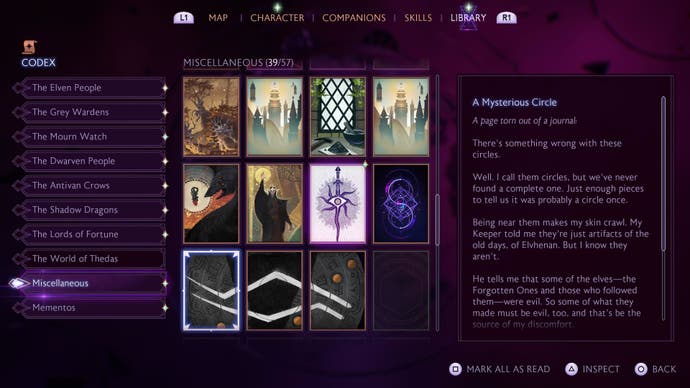
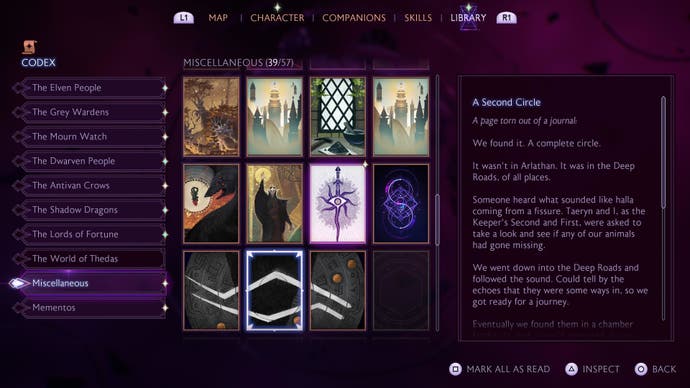
The third entry I will share in full, and you’ll see why:
“I don’t know how Taeryn and I are still alive. But we shouldn’t be.
“We’d been combing through old journals, missives, anything that spoke of the air feeling greasy. That seemed to be the sign of the mysterious circles, and even the broken ones had given off some of that same quality.
“We found what we were looking for in an old scouting report from Clan Sabrae. They’d found a collapsed section of the Deep Roads that seemed to lead under the ocean – or at least they reported the smell of seawater.
“So Taeryn and I went there. We got a little deeper than the Sabrae scouts, and we found another of the circles.
“Then we saw them.
“They looked like a person, though oddly dressed. Grey robe, grey helmet, and a mask.
“Then they moved. Fast. They were suddenly in front of me. And they were reaching out – but there was something wrong with their arm. It was changing, shifting.
“I’ve fought ogres, demons, and more than one templar. But I’ve never been so afraid, or so sure I was going to die. I couldn’t move.
“Taeryn saved me. She hit it with an arrow in the chest. It stumbled back, and that broke the spell. We ran. But we could feel it behind us, and it was getting bigger.
“We lost it. I still don’t know how. But I’m not looking for these circles anymore.
“Let the past keep its secrets.”
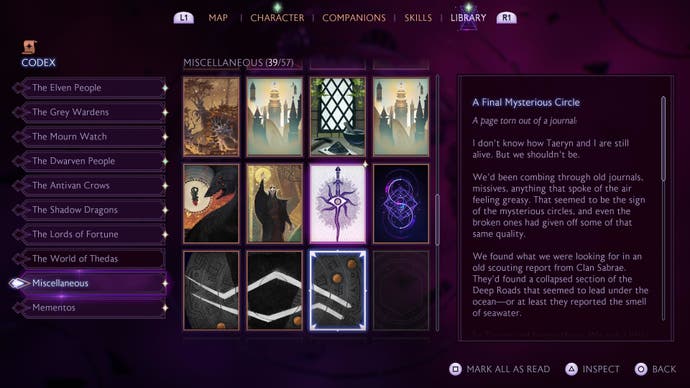
That sounds very similar to the Executor descriptions we’ve had so far, including the smell of the ocean, and it adds the detail that they are fast and can potentially shape-shift. Gulp.
One final detail about the codex entries: when all three are aligned next to each other as cards in your codex library, they recreate the image of the symbol we see at the end of the post-credits scene. Incidentally, I can’t place what appears to be writing around the symbol. It looks like a mixture of dwarven and qunari and elven, but it’s not a match for any of them alone, suggesting it may well be something else, something new.
In The Veilguard, there’s also a mysterious wall in Dock Town, in the city of Minrathous (see the screenshots in this article for a map location), where someone has pinned pictures referencing events from previous Dragon Age games, and then attached string to them, much as an investigator would when visualising a complex case. It’s open to interpretation, but the main mystery of this scene revolves around a picture of a shadowy figure on the right-hand side; the red string connecting all previous games also connects to them. Given the implications of Veilguard’s post-credits scene, this could well be a reference to the Executors.
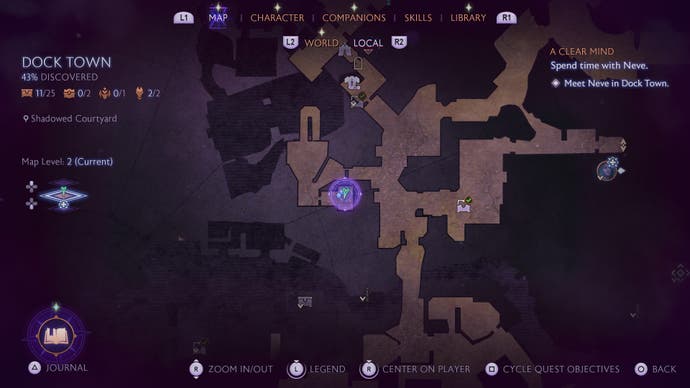
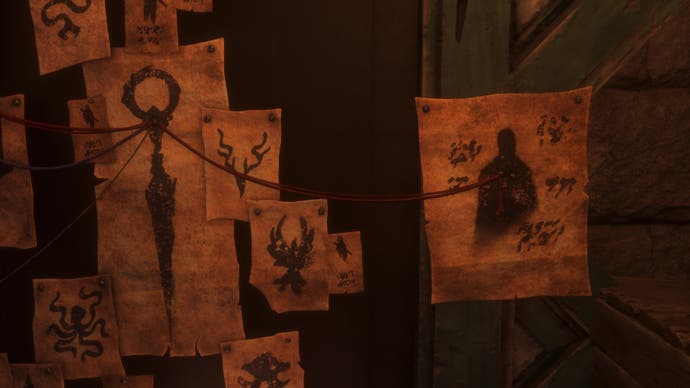

There’s also reference to an oversea danger at the culmination of Taash’s storyline, too, where we learn that the Qunari – who come from overseas, remember, from the north, from Par Vollen – have long battled an enemy referred to as the Devouring Storm. “If more of us flee across the ocean, it means our people failed,” the translation of a sacred tablet tells us. “Prepare then for the Devouring Storm.” Hearing this, our player character Rook responds: “You know, the more we find out, the more it seems like there are big evils of some sort everywhere.” It’s a clunker of a line, but it’s a telling set-up for something new. Does this also refer to the Executors, or something the Executors are involved in?
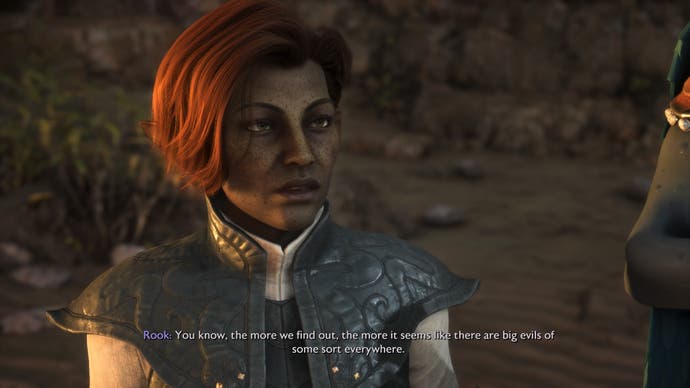

There’s just enough groundwork, then, to suggest BioWare seeded these Executors purposefully, years ago – though it’s so subtle that their revelation still comes as a shock. I asked David Gaider, the original creator of Dragon Age’s world and lore, about the Executors, because we talked recently about an “uber-plot” BioWare created detailing the series’ overarching storyline and I wanted to know whether these Executors were on it. But Gaider respectfully declined to comment, saying this was a question for BioWare now and not him. I asked BioWare for a comment accordingly, but EA replied saying it didn’t have anything further to add.
However you feel about the Executor surprise, they do offer Dragon Age something it desperately needs: a change. Across four games now, we’ve fought the pestilence known as the Blight, with its archdemons and darkspawn, and we’ve fought over-reaching demons from the spirit world of the Fade. And we’ve done it primarily in one place – the only continent in the known world of Thedas. Perhaps it’s finally time for BioWare to expand upon this world and for us to set sail elsewhere.
What’s more, The Veilguard has tied up a lot of the ongoing story arcs we’ve been following. We now know what the Blight is and how it was created, and how it was being controlled, and the beings who were controlling it have been destroyed. The only godlike being of elven legend who remains is Solas, and he’s locked himself away in a magical prison of his own making. The dragons referred to as Old Gods have all gone – only the Old God Baby from Origins remains, and we don’t know his whereabouts. What’s left, really, are loose ends to pursue out of curiosity; we lack an active threat to tie it altogether, which the Executors could give.
It’s intriguing; if the Executors have had a hand in all previous major world events, it would mean they’ve been around for thousands of years – long enough to influence the Tevinter mages and to be aware of the true nature of the elven gods, and events they were wrapped up in. That Solas knows of them strengthens this idea. But are they individual beings who’ve lived that long, which would make them individually very powerful, or is this an organisation that’s spanned millennia and managed to infiltrate empires and organisations at will?
If they are individually powerful (and their description in the Final Mysterious Circle codex in The Veilguard suggests they are), then what place do they hold next to entities such as Titans and godlike elves such as Solas? The way Solas petrified one so easily in the Tevinter Nights book suggests he overpowers them. So what are they, and perhaps more importantly, what do they want? What “poisoned fruit” do they refer to that has now ripened? Are we about to uncover a whole new kind of enemy somewhere we’ve never been before or have they twisted something we already know? Where do the Executors even live? There’s plenty to think about.
It’s a new mystery for a new era. I only hope that in establishing it, BioWare honours what came before rather than smothers it. Here’s to another 10 years of wondering?
